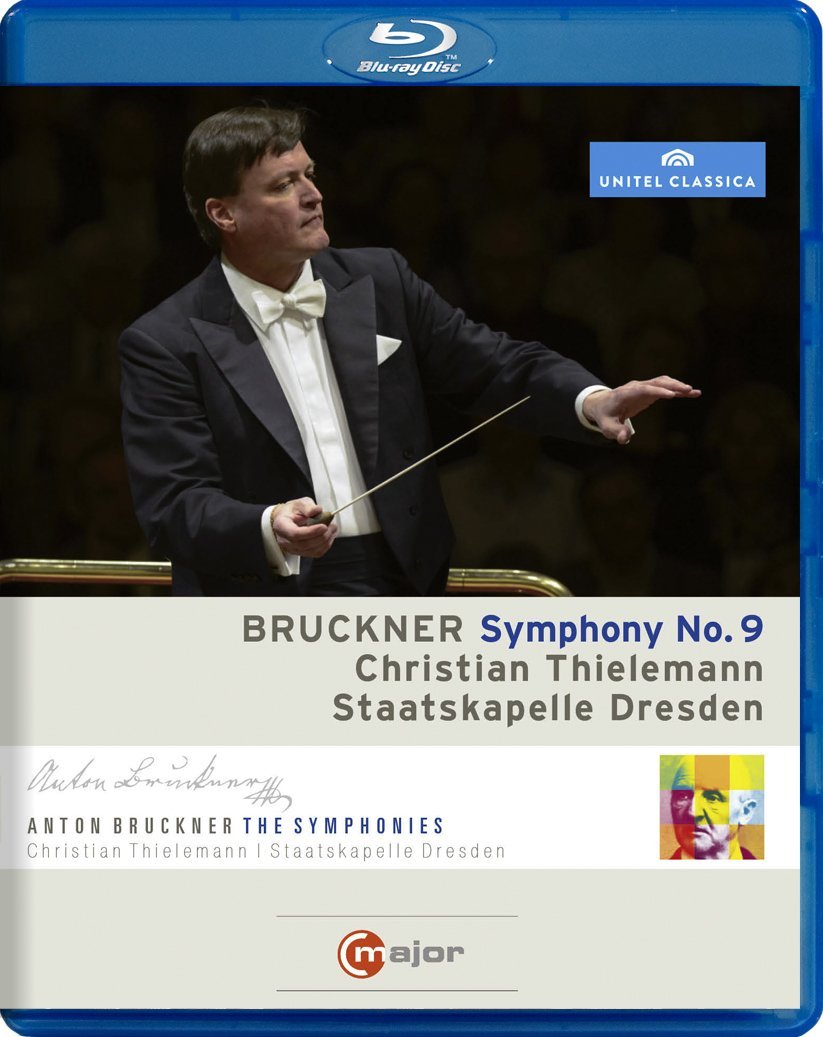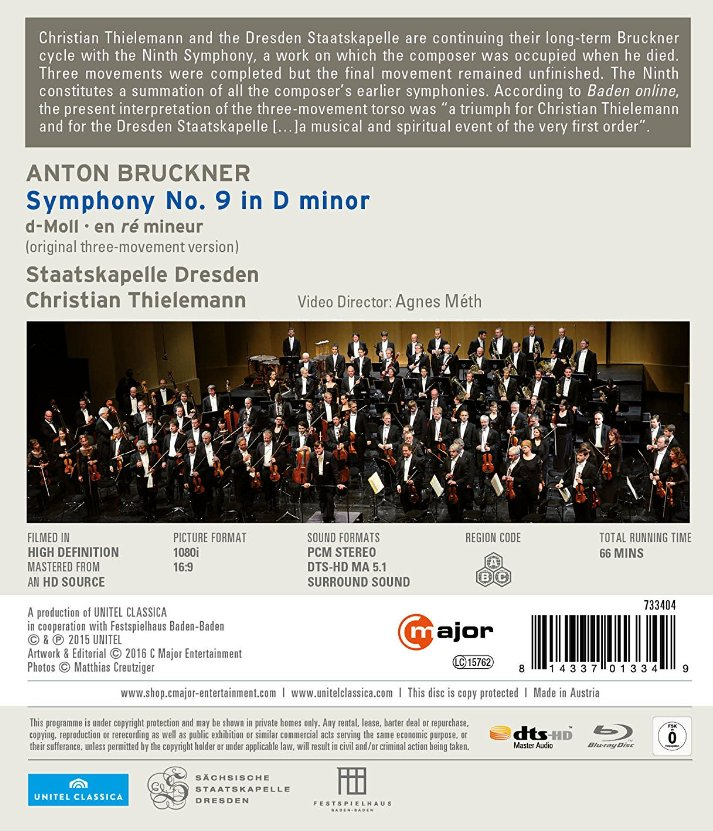

Bruckner Symphony No. 9 in D Minor (Edition: Alfred Orel). Christian Thielemann conducts the Dresden Staatskapelle at the Festspielshaus Baden-Baden in 2015. Directed for TV by Agnes Méth. Released 2016, disc has 5.1 dts-HD Master Audio output. Grade: B-
[Although this story is written with first-person references, it is joint effort between Hank McFadyen (screen shots and associated commentary as well as overall story editing) and Bryan Balmer (performance comparisons and observations, statistics, and album grading.]
Thielemann wants you!
This 2015 recording of Bruckner’s Symphony No. 9 by Christian Thielemann has reinvigorated my interest in this work, and I found the performance to be captivating and generally of high quality.
I have a 2nd Blu-ray performance of Bruckner’s final symphony, Haitink conducting the Concertgebouw (on NHK), and these are a few observations between the two:
Haitink video quality is higher (sharper images, more supershots, more time per clip)
Haitink audio is 96kH/24-bit, Thielemann is 48kH/24-bit
Thielemann audio seems to be recorded at a closer perspective than the Haitink, which brings out the woodwinds and some other instrumental detail more clearly. This doesn’t necessarily imply a better quality audio, but rather some different qualities. As a comparison, pizzicato strings have a glowing presence on the Thielemann Blu-ray in an excerpt between 10:30 to 10:53; whereas, on Haitink, they are not nearly as magical or audible (48:52 to 49:20)
Timings between the 2 recordings are very similar in my view:
|
Movement |
Thielemann |
Haitink |
|
I. |
24:52 |
25:37 |
|
II. |
10:29 |
10:47 |
|
III. |
26:15 |
26:28 |
The string playing in Thielemann's first movement is especially moving for me — the deep emotive tones seeming perfectly suited to the grand sweeping melodies that could be right out of a Hollywood movie soundtrack. The pizzicatos that open the second movement come off with a terrorizing mechanical accuracy, with great intensity. This is contrasted later in the central section of the scherzo, where a dancing joyfulness is conveyed . . . reminiscent to me of a holiday Tchaikovsky ballet.
It was only in the third movement where I had some occasional doubts regarding interpretation and performance. In the sparser moments of the final movement, where time is almost suspended, Haitink’s performance carries much more forward momentum. The atmosphere created by Thielemann is more toward one where time and motion have become entirely suspended. I had a personal preference for Haitink, but I can see a case for both. Thielemann’s approach did require his brass section to perform closer to the edge of their limits, and therefore the Concertgebouw brass section comes off as being much more secure in both tone quality and intonation. For someone who might want to compare, these are some timings and notes:
|
Thielemann |
Haitink |
Notes |
|
19:50 to 20:39 |
58:01 to 58:52 |
This section provides an example of differences in orchestral balance between Thielemann and Haitink. Thielemann brings out the horns much more, whereas Haitink focuses on the strings to a much greater extent. |
|
39:05 to 40:57 |
1:18:30 - 1:20:34 |
This is an example where Haitink brings more forward momentum to a section than Thielemann. He appears to achieve this by asking the musicians to play “more sostenuto”. With Haitink the brass chorale sounds warm, whereas with Thielemann the brass tone is thinner and intonation sounds as though it is becoming less secure (it never fails, but I could hear the struggle!). |
|
44:06 to 45:00 |
1:23:32 to 1:24:23 |
Much more presence by horns in Haitink versus Thielemann, more sostenuto, higher volume as well …which makes it easier for the brass to produce a warm and well supported tone. |
|
46:00 to 49:54 |
01:25:14 to 1:29:04 |
A lengthier comparison illustrating more of the same attributes as mentioned above. In Thielemann, the oboe interjections are more “present” (perhaps due to the overall closer-perspective audio experience, or just a balance decision?), whereas the strings are given greater emphasis by Haitink. |
Agnes Méth had the cameras to make a wide variety of shots. The first view below shows the whole orchestra waiting for the conductor; Méth uses this view frequently:
She also was able to get a wide variety of part-orchestra angles. The nice screenshot below captures all the 2nd violins, violas, and cellos. (This is not a dreaded C/B shot — the context draws your attention to the strings, not the conductor.)
And here below is a similar but closer view of violins and violas:
Apparently a side camera on the stage was the best way to show the first violins. This is a close call, but isn't a C/B shot:
Below a beautiful shot of all the winds + the tympani:
And next below is a closer shot of the woodwinds and horns:
And here's a reverse shot of the woodwinds, but this time there's something odd about the focus:
And there are many nice section shots including the next two views of the horn/Wagner tuba players:
And, of course, there are many shots of single players, often in solo mode. Maybe the prettiest of these just happened to be this frame of a solo horn player doubling on a Wagner tuba:
From the shots above, you can see that the videographer had plenty of resources to produce a splendid HDVD of this symphony. But this she failed to to do, probably because she was ordered by the bosses to make a DVD as well. Or maybe the shots you see next are just the product of habits acquired during the DVD era. The next shot is a classic detested C/B shot, which is the first camera view of the orchestra beginning the symphony. Méth couldn't resist sticking Thielemann in the middle of this:
And now flash forward to the last dying notes of the symphony at its end. Again the center of attention is the conductor rather than the musicians — so we have "bookend" C/B shots for this video!
As you will see below in the statistics section of this review, this recording moves fast. Speed seems to put the individual cameramen under production pressure. It seems they don't have time to home in on their prescribed subjects and attend to proper framing and focus. The result is many clips with obvious errors and defects. Next below is a shot of several trumpets and the trombones. Is any of this in focus?
There are many "solo" shots of the concertmaster. Some of them are acceptable if perhaps pointless. But many are just bad like the pair you see next below:
Here's a weird shot. Below you see 4 players at rest with only two in focus. You hear a clarinet loud and clear, but all you see is part of a clarinet that's out of focus. After about 2 seconds, the camera moves up and catches the face of the clarinet player for perhaps a half-second, and then the clip ends. Why didn't this get edited out?
Next below is a hapless victims with her torso severed and the top of her head lopped off — how gruesome!
Maybe 5 times during this film a camera makes a dramatic pan through the entire orchestra. But the movement is too fast and all of these pans are completely ruined by the motion smear you see in the screenshot below. How could this happen in a video made in 2015?
I have to classify the next two shots as instrument-only shots. But I really should put them in a special category called junk or random-image views:
I recorded the following HDVD statistics for the Thielemann performance:
Conductor shots (C) – 50 clips
Conductor over backs (C/B) – 33 clips
Solos, small sections (S§), small groups (SG), & misc. small-scale or DVD-like views – 324 clips
Large section (L§), large groups (LG), & misc. large-scale or HDVD-like views – 52 clips
Part orchestra (PO) – 56 clips
Whole orchestra (WO) – 18 clips
Instrument only (IO) – 65
Other (backs of musicians) – 4
This totals of 602 clips (between 00:42 and 01:02:35 of the Blu-ray – total time of 61 min 53 s). This gives a pace of 6.2 seconds per clip …which is far too fast for my taste, and a sure sign of “DVDitis”. I can’t understand why a director would make this choice when the user experience is so greatly improved with a slower pace! I did note the clip pace in the 2nd movement scherzo was faster than in the outer movements, although there were occasional instances throughout where successive images flashed on the screen for only a second or two…making it a little difficult at times to record accurate statistics.
This Blu-ray marginally meets some of the other HDVD criteria, all of which are discussed elsewhere on this website:
Supershots (L§, LG, PO, WO) = 21%
Conductor (C + C/B) = 14%
Despite the relatively low count of conductor shots, 65 “instrument only” (IO) clips is a negative in my opinion.
In closing, Thielemann manages a strong performance of the Bruckner Symphony No. 9, and I believe the quality of the Blu-ray production will not seriously impede a viewer’s total experience. In fact, there is much to enjoy in the production values . . . and I have confidence that I will enjoy this Blu-ray many times over the coming months and years. Given my personal preference for a closer audio perspective, I will probably often select this version over Haitink’s (although I feel fortunate to have both in my collection!) despite the fast clip pace.
In trying to achieve consistency in grading versus other titles on this site, my rationale for an overall grade follows:
start with A+, deduct for sound not being 96/24 (brings us to A)
deduct a full letter grade for the pace, as it isn’t even close! (brings us to a B)
deduct for the instrument only shots (brings us to a B-)
I think that the few performance misgivings are balanced out by other glorious moments, so I won’t modify the grade further
Overall Grade: B-
Update on 2016-04-18 21:12 by Henry McFadyen Jr. Many thanks to new wonk Bryan Balmer for the detailed and perceptive review of the Thielemann Bruckner Symphony No. 9! I agree that the performance, the recording, and the SQ on this title are outstanding. The main mission of this website is to encourage recording companies to build up for generations to come a great library of fine-art works to be shown via HDVD in home theaters. The thing that is new about this is our focus on the video aspects of recordings in addition to the performance and sound recording aspects. So Bryan has graded the Thielemann recording lower than the Haitink recording even though Bryan personally prefers the Thielemann version! In that way he splendidly supports our mission. But he also gives you the information you need to make your own choice in this particular case. Our hope is, of course, that Thielemann will record this again when he can insist that the video be made in a way that takes full advantage of HD TV to be seen in home theaters.
Update on 2016-04-15 14:46 by Henry McFadyen Jr. Christian Hoskins, writing in the April 2016 Gramophone at pages 53-54, says, "I was struck while watching [this Thielemann Bruckner 9] how much camera movement there is under Agnes Méth's direction . . . it seems that every third shot involves the picture moving right or left, zooming in or out, floating over the orchestra . . . or featuring a slow crossfade from one camera to another. . . I found it somehow distracting when listening to Thielemann's new performance." As usual, you can't tell if Hoskins saw this in Blu-ray. But I suspect that he did. Maybe now even the print critics are getting weary of the DVDitis they are seeing.
OR





















